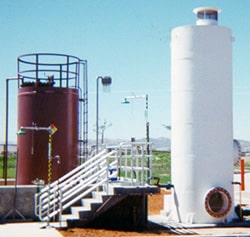Understanding De-Aeration and Decarbonation in Water Treatment Systems
 De-Aeration and decarbonation are two essential processes used to remove carbon dioxide (CO2) and dissolved oxygen (O2) from water streams, particularly in boiler-feed water systems. While both processes share the goal of eliminating CO2, they differ in their approach to removing oxygen. A De-Aeration system focuses on removing both CO2 and O2, while a decarbonation system primarily targets the removal of CO2. Let's delve deeper into these processes to understand their mechanisms and benefits.
De-Aeration and decarbonation are two essential processes used to remove carbon dioxide (CO2) and dissolved oxygen (O2) from water streams, particularly in boiler-feed water systems. While both processes share the goal of eliminating CO2, they differ in their approach to removing oxygen. A De-Aeration system focuses on removing both CO2 and O2, while a decarbonation system primarily targets the removal of CO2. Let's delve deeper into these processes to understand their mechanisms and benefits.
In a De-Aeration system, steam is introduced at the bottom of the tower. The inlet feed water is heated to near saturation temperature, minimizing pressure drop and venting limits. This ensures optimal thermal operating efficiency of the tower. The steam acts as a carrier gas, stripping both CO2 and O2 from the water as it rises through the tower. The tower is equipped with an internal distribution system and media packing to enhance the removal of dissolved gases. By the time the water reaches the top of the tower, it has undergone significant de-aeration, resulting in reduced CO2 and O2 levels. This purified water is then ready for entry into the boiler, ensuring efficient and reliable steam generation.
On the other hand, a decarbonation tower employs a counter-current airflow generated by a blower. The air enters the tower from the bottom and travels upward, facilitating the removal of CO2. In an "Induced Draft" system, the blower is located at the top, pulling air up and through the tower. Similar to the De-Aeration system, the decarbonation tower utilizes an internal distribution system and media packing to enhance the removal of dissolved gases, specifically targeting CO2. The counter-current flow ensures effective contact between the air and water, promoting efficient decarbonation. By removing CO2, the decarbonation system helps mitigate corrosive conditions and protects critical components of the water treatment system.
When selecting the appropriate system, various factors come into play, including the specific application, site conditions, and water chemistry.
Consulting with water treatment professionals, such as the experts at DeLoach Industries Inc., can provide valuable insights and guidance tailored to your unique needs. For more information or to explore your options, reach out to DeLoach Industries Inc. at (941) 371-4995.
Implementing effective de-aeration and decarbonation systems offers numerous benefits for water treatment applications, particularly in boiler-feed water systems. By removing CO2 and O2, these processes minimize the risk of corrosive conditions and ensure the longevity and efficiency of the entire system. Optimal thermal operating efficiency, improved boiler performance, and reduced maintenance costs are just a few advantages of utilizing these water treatment methods.
In conclusion, de-aeration and decarbonation play vital roles in water treatment systems, specifically in the context of boiler-feed water. While de-aeration focuses on removing both CO2 and O2 using steam, decarbonation primarily targets the removal of CO2 with the help of counter-current airflow. By employing these processes, manufacturers can safeguard their equipment, enhance operational efficiency, and reduce maintenance expenses. Contact DeLoach Industries Inc. at (941) 371-4995 to learn more about de-aeration, decarbonation, and other water treatment solutions tailored to your specific requirements.
Receive Your Free Odor Control E-Book





